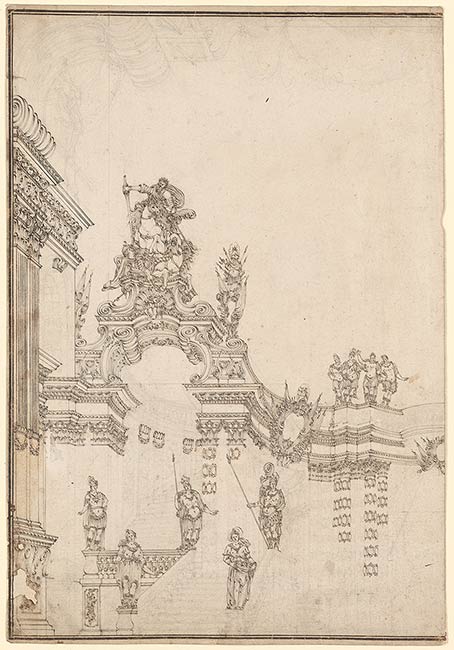

Probably intended for a festivity in connection with the Hapsburg victory over the Turks.
The inscription on the verso of this much-discussed drawing attributes it to Antonio Galli Bibiena and is signed by his younger sister, Maria Ester. Given the inscribed year 1721, Mayor (1945, 37) thought that the drawing could have been a plan for a stage set at Teatro Malvezzi, Bologna, for which Antonio produced designs in 1721. Yet, although the inscription does indeed seem to be in Maria Ester's hand, Muraro and Povoledo (1970, 83, cat. 107) draw attention to some similarities to Francesco's designs for the theatre at Nancy (studies for which are now in the Metropolitan Museum of Art, the Museu de Arte Antiga in Lisbon, and elsewhere), note that the drawing does not correspond to Antonio's sketches in the Oenslager album (at the Morgan, inv. 1982.75:97), and suggest that Maria Ester was mistaken and may have confused one of her brother's drawings with one by her uncle, Francesco. Lenzi (Lenzi 1971, 58-59; Lenzi and Bentini 2000, 269) notes that the architectural style of the design is close to that of Francesco, but she retains the attribution to Antonio and proposes that the drawing dates to the moment when Francesco and Antonio worked together on the Teatro Alibert in Rome in 1719-20.
Inscribed on verso, in pen and brown ink, "1721 / Disegno del gran Antonio Bibiena / Io. Maria Ester Galli Bibiena / Bologna".
Mayr, Michael, 1796-1870, former owner.
Fájt, Marianne, -approximately 1955, former owner.
Scholz, János, former owner.
Oenslager, Donald, 1902-1975, former owner.
Deanna Lenzi. “Problemi bibieneschi in margine a una recente mostra.” Paragone 22.259 (September 1971): 42-67.
Maria Teresa Muraro and Elena Povoledo. Disegni Teatrali dei Bibiena. Exh. cat. Venice: Cini Foundation, 1970 (83, cat. 107)
Mayor, A. Hyatt. The Bibiena family. New York : H. Bittner, 1945, pl. 42.
